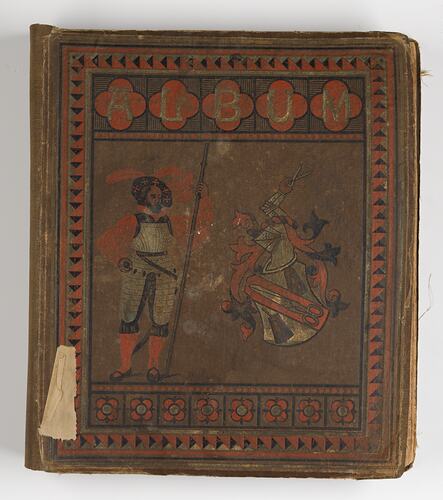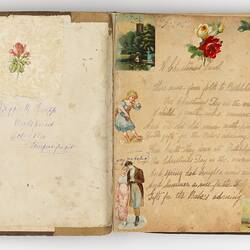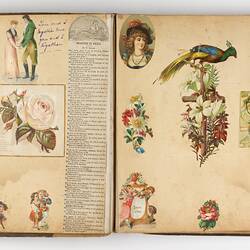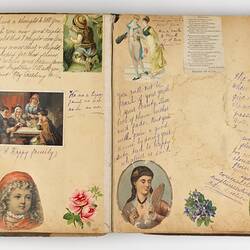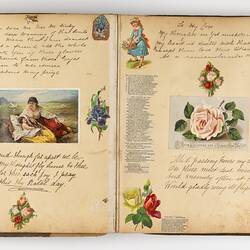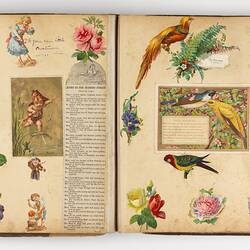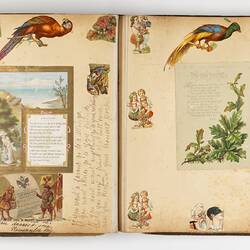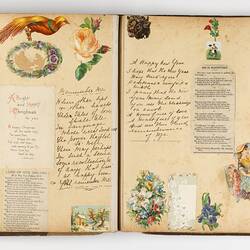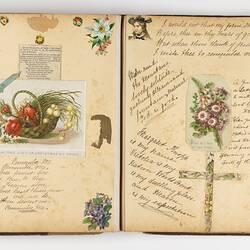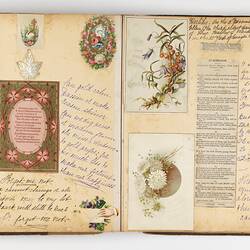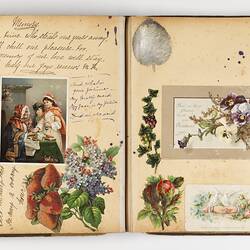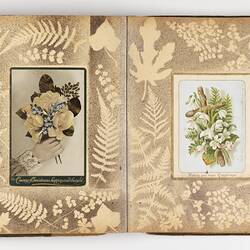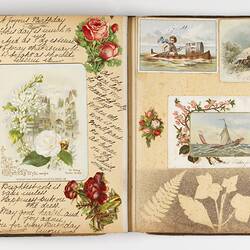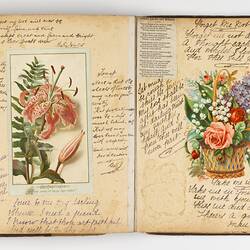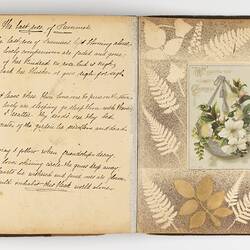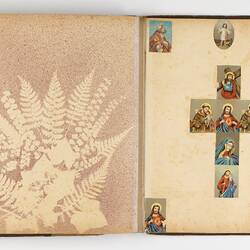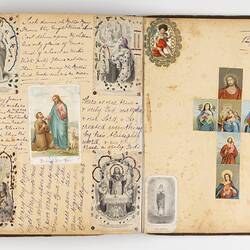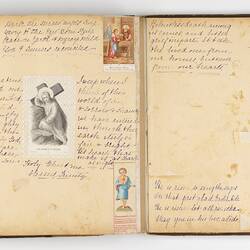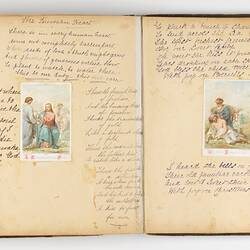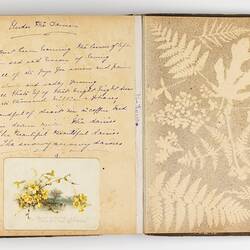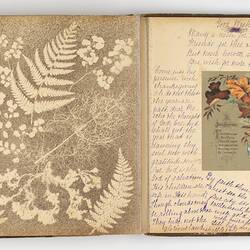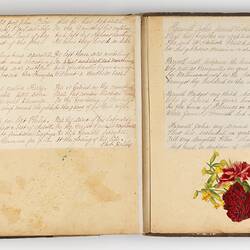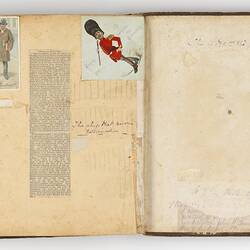Summary
Alternative Name(s): Scrap Book
56-page scrapbook, compiled by teenage Margaret (Maggie) Knopp in Woods Point from 1884. Cream pages onto which are adhered cut-outs from greeting cards, religious cards, newspapers and other printed ephemera. The scrapbook includes splatter-work images of ferns, perhaps from the local area, and even a dried bouquet of flowers, interspersed with hand-writing, including transcribed poems and wise words.
Maggie was born in 1870, at Black River, a gold mining settlement near Woods Point, north of Mt Baw Baw, and north east of Melbourne. Her mother, Catherine Foley, was an Irish immigrant (arrival date unknown); her father, John Knopp, was a German immigrant who arrived in Victoria with his brother in 1860 and was soon prospecting in the Woods Point area. The couple is thought to have married in 1868, and had six children, only two of whom survived to adulthood. Around 1880 Catherine and her surviving children moved into Woods Point proper. The family would have had access to several local newspapers, and a lending library and delivery service for publications was available. The children probably attended the single local school. In 1884, at the age of 14, Margaret ('Maggie') began to compile the scrapbook.
The scrapbook shows Maggie as intensely romantic, with little cuttings of flowers, beautiful women, handsome men and courting couples (one inscribed in her hand-writing 'say yes darling'). Poems and wise words speak of love and longing (for example, 'I do love violets, They tell the story of woman's love', page 20). Some of the content instructs on appropriate standards of behaviour - for example, 'What a girl should learn', page 6 - including 'To sew', 'To cook', 'To mend', 'To be gentle', 'To marry a man for his worth' and 'To humour a cross man'. Some of the images reflect the world of the early to mid-19th century, rather than her own time. She shows little interest in current affairs, except for a page dealing with serial killer Frederick Deeming, including the date of his execution, and other death notices. Page 30 includes a card from the International Inventions Exhibition, London, 1885. Religious iconography is also a theme - for example, a series of religious images is pasted in the form of a cross on page 35.
Page 54 includes a poem by Thomas Herlihy, lamenting his friend John Foley, with whom he immigrated in 1857. Thomas's family and Maggie's family seem to have been acquainted: Catherine apparently attended the birth (and subsequent death) of his son, and Maggie records the death of two of his daughters in her scrapbook.
Physical Description
Scrapbook, 56 pages (28 leaves), plus hard cover. Cover is brown with red, black and gold print. Features image of man in body armour with feathered cap and knee-length pants, as well as a crest with armour. Cream pages, heavy paper, onto which are adhered cut-outs from greeting cards, newspapers and other printed ephemera. Interspersed with hand-writing, including poems and wise words. Page 35 has a small posy of dried flowers.
Significance
The scrapbook is significant both for its content and its rarity. More than a mere collection of cuttings, it is a richly illustrated document, with material from a wide range of sources, from gift and religious cards to newspapers, interspersed with hand-written poems copied from other sources, and little notes by the author that add meaning to the images and provide an insight into how she regarded her work. It provides a layered and important insight into the world of late 19th century Victoria, and in particular the life of a teenage girl living in an isolated rural area, well beyond the city. It documents a range of issues and interests that entranced her, including migration, death, and perceptions of romance and marriage. Both of the scrapbook maker's parents were themselves migrants (from Germany and Ireland), and the maker includes a lament for a fellow immigrant. She records several deaths including two daughters from one family and a murder. Above all, she shows herself to be a true child of the Romantic period, exploring way to express her feelings, looking to nature for beauty and inspiration, recording the mores of courtship, adding captions to romantic images, and adorning her work with poetry, flowers and beautiful scenes.
The scrapbook also played an important cultural role. It provided not only a moral framework for the maker, as it did for her contemporary scrapbook-makers: as Ellen Gatrell notes, it also taught organization and the classification of information, and developed aesthetic interests and skills.
More Information
-
Collecting Areas
Childhood, Leisure, Home & Community, Migration & Cultural Diversity
-
Acquisition Information
Donation from Louise Blake, 23 Sep 2009
-
Acknowledgement
Donated on behalf of Hyland, Howitt and Hester families
-
Maker
Margaret M. Knopp, Woods Point, Victoria, Australia, 1884
Date scrapbook was started. -
Inscriptions
On cover: 'ALBUM'. Inside cover: 'Maggie M. Knopp. / Woods Point / Oct. 1884 / Tempus fugit'.
-
Classification
-
Category
-
Discipline
-
Type of item
-
Overall Dimensions
260 mm (Width), 50 mm (Depth), 310 mm (Height)
-
Overall Dimensions - Closed
316 mm (Length), 272 mm (Width), 51 mm (Height)
Measurement From Conservation. Before Treatment
-
Overall Dimensions - Closed
312 mm (Length), 270 mm (Width), 47 mm (Height)
Measurement From Conservation. After Treatment
-
References
Louise Blake, 'Woods Point is my Dwelling Place: Interpreting a Family Heirloom', Public Records Office Victoria research publication, 2009 - [Link 1] Louise Blake, website including 'Women on the Upper Goulburn Goldfields' and the Knopp family, [Link 2] accessed, 29 Mar 2021. Ellen Gatrell, 'More About Scrapbooks', Duke University Library [Link 3] accessed 29 Mar 2021.
-
Keywords
